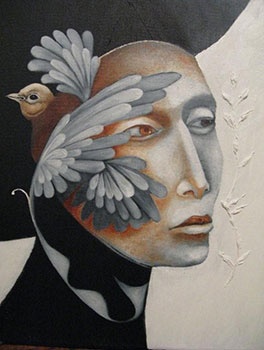Mexican-American artist Rene Alvarado currently has an exhibit at the San Angelo Museum of Fine Arts through November 12.

"Madonna and Two Horses"
Is this stuff cool, or what?

"Songbird"
If you go to the artist's website, you can see even more of his fantastic paintings -- and find out more about the artist, whom I'd never heard of before hearing of him on KUT a few days ago. On the website his work gets compared to Mexican artist Rufino Tamayo's, but I see similarities between Alvarado's work and a host of others. You can see the surrealist influence of Dali, without a doubt, and an almost Chagall-like dreaminess. Picasso is there as well. But what Alvarado brings to the table is a specifically Chicano approach to these surrealist landscapes. According to his site, he is concerned largely with the psychology of identity. His parents brought him to the States when he was 7, and it is through his art that Alvarado tells the story of creating a new life in West Texas.
Recurring images in his work are bulls, the sea, and the female form. In some paintings Alvarado seems to be asking us to contemplate the art of display, as his still lifes stare back, accusingly, at the viewer. In another eerie painting, all in red hues, three mysterious bird-like creatures look over the sculpture of a torso -- with a dolphin's head. I chose the two paintings here because they seem to represent two different directions Alvarado takes in his work: abstraction and portraiture. In the first, the Madonna's triangular form occupies most of the canvas, her dark head and halo standing out against the softer pastels. Within those pastels, horses and fish and faces lurk, swimming and whispering and standing alert. The triangle of the Madonna's form intersects with a second, shadow triangle, the base of which is the blue feathers behind the horses' heads. All these triangles -- not to mention the look of the Madonna's head -- bring to mind ancient Mesoamerican civilizations that this Madonna might have been a part of.
The second painting, "Songbird," doesn't beg for the same kind of symbolic unpacking. It's what Alvarado does with color here that's so interesting to me, the play of shade and light that makes the soft grey feathers on the bird stand out so strikingly against the woman's hair. On the right side of the painting we see the faint imprint of a flower shoot.
Alvarado has converted an old church in San Angelo into his studio, blending community, tradition, and functionality in practice as well as in his art. It may be well worth the 4 1/2 hour drive from Austin to see.


Recent comments
2 years 29 weeks ago
2 years 44 weeks ago
2 years 44 weeks ago
2 years 50 weeks ago
3 years 4 weeks ago
3 years 4 weeks ago
3 years 4 weeks ago
3 years 6 weeks ago
3 years 6 weeks ago
3 years 6 weeks ago